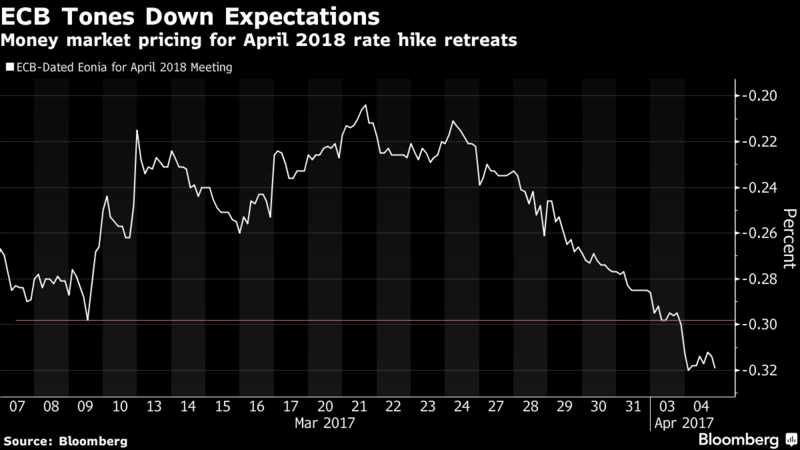Listen Up for ECB Signal in Noise on How Rates, QE Interact

Over the past few weeks, the European Central Bank’s policy debate has sounded a bit like an orchestra warming up. In the next 72 hours though, there’s a chance that a hint of a tune will emerge.
In comments led by ECB President Mario Draghi’s speech at 9 a.m. in Frankfurt on Thursday, and continuing with contributions by policy heavyweights including Peter Praet and Vitor Constancio during the day, before wrapping up with Governing Council members from Ireland and France by Friday, investors are looking for signs of consensus.
That’s because on the biggest monetary-policy questions of the day — how to manage the end of quantitative easing this year and when interest-rate rises will come — officials have spent the past month talking past each other. It boils down to a preference to sticking with the announced plan to run QE until the end of the year and keep rates on hold until well after that, or a readiness to change the rules if inflation accelerates faster before then.
“The ECB is clearly preparing for the exit talk and for tweaks to its forward guidance,” said Florian Hense, an economist at Berenberg in London. “There is definitely a sense that a move is evolving. Policy makers have so far disregarded any discussion about exit, but now they are not only answering questions about it but actually talking about it themselves.”
Exert Discipline
Draghi and ECB chief economist Praet will address a conference dedicated to ECB watchers in Frankfurt on Thursday morning, before the action moves south to Malta, where Vice PresidentConstancio is scheduled to speak on the sidelines of an European Union meeting. Executive Board member Yves Mersch then joins the fray from a gathering at Lake Como in Italy starting on Friday. Governors Philip Lane of Ireland and Bundesbank President Jens Weidmann are also scheduled to speak during the period.
“The time to not have the foot pressed down on the gas pedal, but to lift it slightly” is approaching, Weidmann said in an interview with Die Zeit published on Wednesday, adding that he hoped asset purchases will be finished one year from now.
For Draghi, the appearance will be an opportunity to exert some discipline over the policy discussion. While the idea that rates might rise before QE comes to a halt has some currency — for instance with Austrian central-bank Governor Ewald Nowotny — Praet has strongly warned against entertaining that thought now.
Italy’s Ignazio Visco, the Netherlands’ Klaas Knot, Belgium’s Jan Smets and Finland’s Erkki Liikanen have also weighed in separately on various aspects of the sequencing and QE discussion, with the balance being broadly in favor of keeping the settings on hold.
“We have stated that rates would remain low beyond the end” of asset purchases, Liikanen said in an interview with Germany’s Handelsblatt on Wednesday. “It has not been contested at the time.”

It’s that uncertainty though that’s confusing investors, who had begun to price in earlier rate hikes after the ECB’s last policy meeting in March even though the strengthening economic performance hasn’t yet been matched by the kind of broad-based, sustained gains in inflation that the ECB would like. Those assumptions were then tempered as officials like Praet gained the upper hand, and actual inflation developments made the question less urgent.
Euro-area inflation slowed to 1.5 percent in March after an oil-driven jump to 2 percent. The core rate, which excludes energy and food and is seen by the ECB as a signal of where headline inflation will stabilize, weakened to 0.7 percent from 0.9 percent — the weakest reading in almost a year.
Cacophony Risk
But even if markets are listening to Praet rather than Nowotny for now, the influential voice of Benoit Coeure is usually worth paying attention to. He signaled he’s open to having a discussion on whether the sequencing of rates and QE changes can be altered, when the time is right. Investors could still find themselves facing higher borrowing costs before stimulus stops flowing.
Perhaps with some irony, Coeure warned last week of the risk of “cacophony” when too many central bank speakers are in play at once.
That’s especially true, according to Jonathan Loynes, chief economist at Capital Economics, when policy makers themselves don’t really know what they will do next, and are feeling their way forward, as is now the case.
“The ECB has made the mistake once or twice before of tightening too early,’ Loynes said. “Forward guidance is a pretty strong commitment that’s costly to break, because if you do it next time the market won’t believe you.”
Source: Bloomberg
HEADLINES
- Do shipping markets want Biden or Trump for the win?
- All 18 crew safe after fire on Japanese-owned tanker off Singapore
- Singapore launching $44m co-investment initiative for maritime tech start-ups
- Cosco debuts Global Shipping Industry Chain Cooperation Initiative
- US warns of more shipping sanctions
- China continues seaport consolidation as Dalian offer goes unconditional